How to Evaluate and Manage Storm-Damaged Forest Areas |
By
Patrick J. Barry, Entomologist1
Coleman Doggett, Senior Staff Forester2
Robert L. Anderson, Field Representative1
and
Kenneth M. Swain, Sr., Deputy Director3 Management Bulletin RS-MB 63
September 1993
Supersedes Forestry Report SA-ER 20 |
|
|
1USDA Forest Service. Southern Region. Forest Health. Asheville. NC.
2North Carolina Forest Service. Raleigh. NC.
3
USDA Forest Service. Southern Region. Forest Health. Atlanta. GA. |
|
|
|
IntroductionHurricanes, tornadoes, and ice storms strike
somewhere in the South almost every year. They cause extensive forest damage by uprooting, wounding, bending, and breaking trees. Standing water, which often accompanies hurricanes, can cause additional stress and
mortality. When one of these natural disasters occurs, it is important to have a plan for managing damaged timber. |
|
Development of a storm damage management plan involves several systematic steps. As soon as possible, the area should be sketch mapped or aerial photographed.
The next step is to ground check the damage to determine the need for salvage. Priorities for salvage will depend on location, amount and type of damage, and management objectives. This guide presents methods managing storm-damaged
trees to reduce growth loss, product degrade, and mortality. In the process, other factors such as threatened and endangered species must be considered. The information presented here will assist in setting priorities |
Survey the DamageTwo types of surveys, general and intensive, are needed to
determine the extent of forest damage from a storm. General surveys are designed to determine geographical area affected by storms. These are very quickly and easily done from the air. Using aerial survey techniques,
damaged areas may be sketched on preexisting maps or photographs, or damaged areas may be aerially photographed. A planimeter or other device is then used to determine acres affected. Intensive surveys are designed to
collect information on volumes of timber damaged and on conditions of surviving trees. Volumes of storm-damaged timber are difficult to estimate with aerial survey techniques because damaged trees are broken and twisted
together. It is also difficult to determine tree condition from the air. Consequently, intensive surveys usually require ground-based plots for acceptable accuracy. The number and size of plots are determined by desired
accuracy, and by time and personnel constraints. |
|
|
Tornado damage surveys are unique because the storm tracks are usually long and narrow with few surviving trees. Volumes of tornado damaged timber may be
estimated by taking systematic plots on a transect parallel to the storm track but just outside the damage area. |
Note Types of Damage and Take Action BreakageBreakage Breakage
is the most common type of storm damage. Its impact depends on the degree and pattern of damage as well as the tree species involved. Breakage inevitably lowers timber values. Breaks are uneven by their nature and
occur randomly along the tree bole. The random pattern lowers value since products are normally cut in specified lengths. Breakage also lowers value because difficulty in logging in broken timber slows productivity.
Patterns are important when assessing breakage impact. When ice or strong gale-force winds break trees, break patterns are simple and limited to the area adjacent to the breakpoint. Hardwood trees are seldom killed by
breakage. Even when tops are completely gone, new branches will sprout and the tree will recover. In hardwoods, the major problem is that breaks in the trunk or large branches (over 3 in. diameter) permit entry of stain
and decay fungi. Stain will move vertically from the injury at a rate of 6 to 18 inches per year, and decay will follow the stain in 8 to 10 months. |
|
|
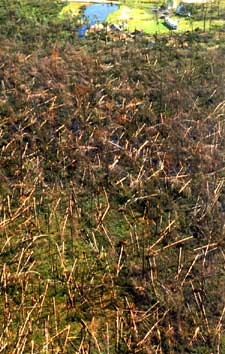 |
|
|
Hurricane-damaged stand. |
|
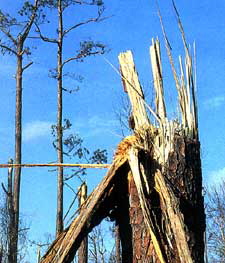 |
|
Pine tree with broken main stem. |
|
|
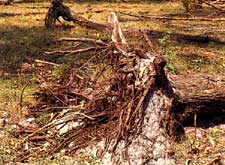 |
|
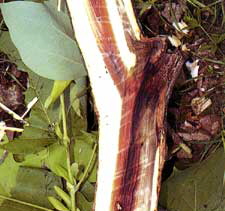 |
|
Internal stain on a previously damaged tree. |
|
|
Most species of pine will die if tops are completely broken and no live limbs remain. If three or more live limbs are left in the tops of
loblolly or slash pines, the chance of survival is excellent (above 75 percent). One of the lateral branches in these trees will become the terminal, and in 8 to 10 years the only sign of breakage will be a sharp crook
in the bole at the point where the break occurred. These trees will experience growth losses, however.Recommendations For hardwoods, trees with broken tops or branches over 3 inches in
diameter should be salvaged during the next scheduled harvest. High-value trees such as those in recreation areas and in yards should be properly pruned to promote rapid healing. For pines, if three live limbs or less
remain, the trees should be harvested as quickly as practical. Twisted Trunks The cyclonic winds that are typical of tornadoes, and often accompany hurricanes, cause twisting and separation of wood
fibers in the main stein. Logs from trees that have experienced this treatment may fall apart when sawn for lumber products. Trees twisted by cyclonic winds may appear normal, except that pines often have pitch flow
along the trunk. Recommendations Trees with evidence of twist injury should be removed, since the problem will not disappear with time and considerable losses may be incurred during a
later harvest. Root Damage If they are not salvaged promptly, uprooted trees probably will be degraded quickly by stains, decays, and secondary insects, such as Ips
bark beetles, borers, powderpost beetles, and ambrosia beetles. The longer salvage is delayed, the greater the amount of degrade and weight loss from rapid drying. Degrade translates into a stumpage value loss. The amount of degrade that is acceptable to industry depends on the tree species and local markets. Table I shows the probable sequence of invasion by damaging organisms in storm-damaged timber.
|
|
Table 1- Sequence of invasion of damaging organisms in storm-damaged timber |
Species |
Year 1 |
Year 2 |
Pine |
Bark beetles, ambrosia beetles, sawyers, blue stain fungi, soft rot fungi |
Decay fungi |
Oak and hickory |
Wood borers, ambrosia beetle, stains, soft rot fungi |
Sapwood fungi |
Other hardwoods |
Wood borers, ambrosia beetles, stains, soft rot fungi |
Sap and heartwood decay fungi |
|
|
Root-sprung trees will not die immediately, but will show decline symptoms over a period of several years. These trees may be invaded by root rot organisms and
subjected to drought stress and insect attack. Root-sprung pines may be invaded by bark beetles and blue stain fungi. These pines can serve as prime habitat for the southern pine beetle and, if conditions become favorable, an
outbreak could occur. They can also harbor high populations of turpentine beetles.Recommendations Trees with major root damage should be salvaged as 500fl as possible to avoid growth loss, product degrade,
bark beetle attacks, and mortality. |
Major WoundsDuring storms, many trees sustain wounds caused by
falling tops, adjacent uprooted trees, and major branch breakage. In hardwoods, wounds that do not penetrate more than 2 inches into the sapwood and have less than 144 square inches of surface area will have only
localized stain, but little decay. Wounds that exceed these limits will have stains and decay that move at the rates described for broken branches. Pine trees with major wounds to the lower bole and larger roots may be
attacked by bark beetles. Recommendations Trees with major wounds should be considered for removal during the next scheduled harvest, or they should be included in the salvage operation.
Bent Trees Bent hardwoods usually are not attacked by insects or diseases because they are not in a stressed condition. Pine trees that are bent to the extent that cracks and resin flow
occur may be invaded by bark beetles and disease-causing organisms. |
|
|
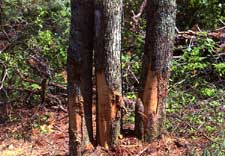 |
|
|
Wounds associated with storm damage. |
|
|
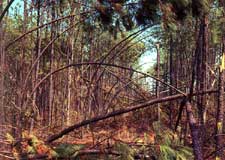 |
|
|
Trees bent during a hurricane. |
|
RecommendationsSmall trees (under 15 feet in height) usually straighten even
after severe bending. Taller severely bent hardwoods should be removed during the salvage operation or the next scheduled harvest. Be sure to inspect large pine timber for pitch flow. Many large, green, standing trees may not be
usable for veneer, poles. or lumber because of internal ring shake, splintering and separation of the wood fibers. Often, the only external evidence of such damage is pitch or sap flow where the injury has broken the bark. These
characteristics are often overlooked, and considerable losses are incurred during a later harvest. |
|
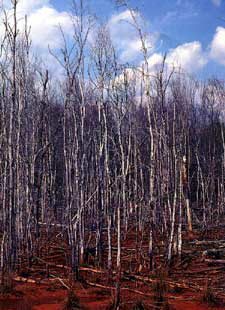 |
|
Trees killed by standing water. |
|
|
Standing WaterIn standing water, the dissolved oxygen is quickly depleted,
so trees of most species are injured by prolonged flooding, particularly during the growing season. The loss of soil oxygen leads to root mortality and tree death. Trees weakened by standing water are often attacked by
insects or affected by diseases. Recommendations Forest managers may wish to favor flood-tolerant trees and shrubs in areas subject to intermittent flooding. Tree species that can tolerate
prolonged or intermittent flooding are noted in table 2. Flood-tolerant shrubs include: buttonbush, sand plum, deciduous holly, and swamp-ironwood. |
|
Manage to Reduce Pest-Caused LossesStorm damage often increases the risk of pest
outbreak by weakening the defenses of host trees. Pest infestations will not develop unless suitable host trees are available, so every effort should be made to remove concentrations of susceptible host trees. A well-planned and
executed salvage operation can greatly increase a stand's resistance to pest attacks. To ensure effective salvage, we recommend the following approach: |
1. Act quickly. Prompt salvage will help avoid losses from degrade and subsequent pest- caused mortality.2. Measure
carefully the extent of the damage before deciding on a salvage operation. A number of factors such as stand age, species, stocking, and management objectives will need to be considered. 3. Salvage the most
severely damaged timber first. Concentrate on the pine stands, because they are more susceptible than hardwoods to pest outbreaks. On deep sandy soils where a stand will be left, the stumps should be treated for annosus
root rot control. During salvage avoid damage to residual trees. 4. Complete salvage promptly and in one continuous operation. Bark beetle populations are more likely to build up in the slash and move into healthy
trees if logging operations are prolonged or interrupted for periods of a month or more. (When salvage is delayed, a helpful guide is available for utilization of beetle-killed pine trees based on tree appearance. See
table 2.) |
|
|
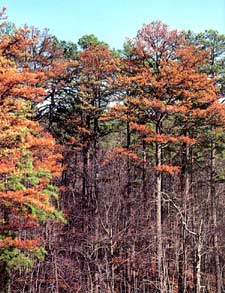 |
|
|
|
Bark beetles often kill weakened trees |
|
|
5. Follow the practices listed below to ensure that the residual material (slash) will dry quickly. Bark beetle infestations will not build up in dry
material.
- Cut all logs from seriously damaged trees to the minimum merchantable size and remove them from the area.
- Lop and scatter all harvesting slash and tops into open areas when possible.
- Scatter large accumulations of slash away from the bases of residual trees, and into direct sunlight if possible.
- Sever downed trees from roots that could keep them alive.
6. Inspect large pines for pitch flow. Many large, green, standing pines may be unusable for veneer, poles, or lumber because of internal splintering and separation of the wood fibers. Often, the only external
evidence of storm damage is pitch flow where the bark has been broken. 7. Follow the ratings of species resistance to insects and diseases in table 3 when planning the salvage of timber, especially hardwoods. 8.
Consider deducting storm-damage losses on income-tax returns. Landowners can secure advice from local foresters, accountants, attorneys, or Internal Revenue Service agents concerning deductible losses.
9. Check for pest activity after salvage operations are finished. Make periodic surveys, either aerial or ground, of the residual stands to check for pest activity. These surveys may be required for up to
2 years. Trees that are turning yellow, have pitch tubes on the bark, or red boring dust around the base, are probably affected by insects, diseases, or both. These trees should be considered for control activities. |
Table 2-Utilization guidelines for beetle-killed pine trees1 |
|
Product |
Class A
Trees with needles or no needles, but twigs attached |
Class B
Trees with no needles, most twigs and branches lost, and some broken tops |
Comments |
Appearance lumber2 |
Not recommended |
Not recommended |
Blue stain prohibits use |
Dimension lumber2 (structural) |
Can be used with caution |
Not recommended |
Should be kiln dried to prevent emergence of secondary insects. Low moisture content may dull saws and chipper knives faster
than with sound wood and may require milder kiln schedule. Do not use where toughness is important. |
Decorative lumber boards and paneling
|
Can be used |
Can be used |
Should be kiln dried |
Posts, poles, piling |
Not recommended |
Not recommended |
Toughness and preservative treatability may be highly variable
|
Plywood |
Can be used |
Not recommended |
Adhesives and gluing practices may have to be adjusted |
Hardboard, particle-board, medium density fiberboard |
Can be used |
Can be used |
Low moisture content may affect some production schedules. Should be mixed with sound wood.
|
Pulp |
Can be used |
Can be used |
Blue stain and low moisture content may affect pulping process and chemical or energy requirements. Should be mixed with sound
wood, particularly where strength is important. |
Fuelwood |
Can be used |
Can be used |
Low moisture content increases heat value |
|
1For more information on utilization of beetle-killed trees, see "A Guide for Using Beetle-Killed Southern Pine Based on Tree Appearance",
by Michael P. Levi, USDA Agriculture Handbook 572.2For more information on economics of producing lumber from beetle-killed pines, see "A Mill Operator's Guide to Profit on Beetle-Killed Southern
Pine", by S. A. Sinclair, USDA Agriculture Handbook 555. |
Manage to Reduce Hurricane DamageTree species vary in their ability to withstand
hurricane winds and salt damage. Wind resistance depends on the interaction of five factors: strength of the wood, shape and size of the crown, extent and depth of the root system, previous moisture conditions, and shape of the
bole. |
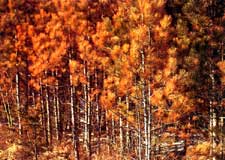 |
|
|
Salt-damagedpines |
|
|
No tree species has perfect wind resistance, but live oak, palm, pondcypress, and baldcypress are among the best, as shown in table 3. These trees
combine deep root systems with buttressed trunks (low center of gravity). The wood of live oak is exceedingly strong and resilient. The crown is usually widespread, but this does not seem to negate its strong points.
Cypress has relatively weak wood, but its crown s so sparse and its foliage so limber that it is also extremely windfirm.Shallow-rooted trees are easily uprooted, especially after the soil is saturated by heavy
rains. |
|
Common shallow-rooted trees along the coast are dogwood, water oak, pecan, sweetbay, and red maple. Common deep- rooted trees are live oak, longleaf pine, and
pondcypress and baldcypress.Trees growing in sandy soils are more deeply rooted than trees crowing in soils with an inhibiting clay layer or a high water table. Although rooting habits vary according to the soil profile, each
species has a characteristic pattern. Another factor to be considered is the height of the tree. The taller the tree, the greater is its chance of breaking, especially if the bole has little taper. For this reason, tall, slim slash
and longleaf pines are extremely vulnerable. Open-crowned and lacy-foliaged trees, such as cypress and mimosa, offer less resistance to the wind, and thus are better able to survive. On the other hand, magnolia trees with their
heavy, wind-catching foliage are windthrown more than their root system and bole structure would indicate. Palm trees offer little surface to the wind because they have almost no laterally extended crown and branches.
This characteristic makes them fairly windfirm, despite their limited root systems. |
Table 3-Resistance of tree species to hurricane-related damage
(In descending order of resistance) |
|
Flood
tolerant |
Breakage |
Uprooting |
Salt |
Deterioration
by insect
and disease |
baldcypress
pondcypress
tupelo-gum
sweetbay
willow
sweetgum
sycamore
river birch
cottonwood
green ash
red maple
pecan
mulberry
American elm
persimmon
silver maple
water oak
swamp chestnut oak
magnolia
hickory |
live oak
palm
baldcypress
pondcypress
sweetgum
tupelo-gum
mimosa
dogwood
magnolia
sweetbay
southern red oak
water oak
sycamore
longleaf pine
slash pine
loblolly pine
redcedar
hickory
red maple
pecan |
live oak
palm
baldcypress
pondcypress
tupelo-gum
redcedar
sweetgum
sycamore
longleaf pine
mimosa
southern red oak
magnolia
slash pine
loblolly pine
sweetbay
water oak
red maple
dogwood
hickory
pecan |
live oak
palm
slash pine
longleaf pine
pondcypress
loblolly pine
redcedar
tupeolo-gum
baldcypress
sweetgum
water oak
sycamore
sweetbay
southern red oak
hickory
mimosa
pecan
magnolia
red maple
dogwood |
live oak
palm
sweetgum
water oak
sycamore
baldcypress
pondcypress
southern red oak
magnolia
tupelo-gum
sweetbay
hickory
pecan
redcedar
red maple
mimosa
dogwood
longleaf pine
slash pine
loblolly pine |
|
Based on these observations, the following preventive measures are recommended to forest managers in hurricane-risk areas:1. Keep a balanced mixture of size and ace classes to prevent a complete loss. Young trees are rarely damaged, because they tend to bend with the wind:
old trees tend to break or uproot. 2. Where feasible, stagger thinnings to limit exposure of the recently thinned areas. |
|
|
(During Hurricane Camille. recently thinned stands of pine with little taper were severely broken. while open stands and stands thinned several years earlier
suffered less damage.)3. Manage for well-spaced, thrifty trees and, as much as possible, develop a spread of age classes to distribute the risk of wind damage.
4. Consider planting longleaf pine in deep sandy soils, because long leaf has a deep taproot. 5. When planting slash and loblolly, use an 8-by 8-foot or wider spacing. Winds often carry saltwater inland
for a considerable distance. The leaves on trees saturated with saltwater turn brown and give tile appearance of being burned. Most of these trees will not die and should not be cut. See table 2 for resistance among tree species.
The trees may lose their leaves and Sonic growth, but most of them will grow new leaves and recover. Check trees closely in the spring after salt damage for adequate recovery or possible bark beetle attack. Trees should be
harvested if they have been attacked by bark beetles or if they have not put on new growth in the first full growing season after the damage occurred. The Forest
Service, U.S. Department of Agriculture, is dedicated to the principle of multiple use management of the Nation's forest resources for sustained yields of wood, water, forage, wildlife, and recreation. Through forestry research,
cooperation with the States and private forest owners, and management of the National Forests and National Grasslands, it strives as directed by Congress-to provide increasingly greater service to a growing Nation.
USDA policy prohibits discrimination because of race, color, national origin, age, religion, sex, or disability. Persons who believe they have been discriminated against in any USDA-related activity should immediately contact the
Secretary of Agriculture. Washington, DC 20250
|
|

